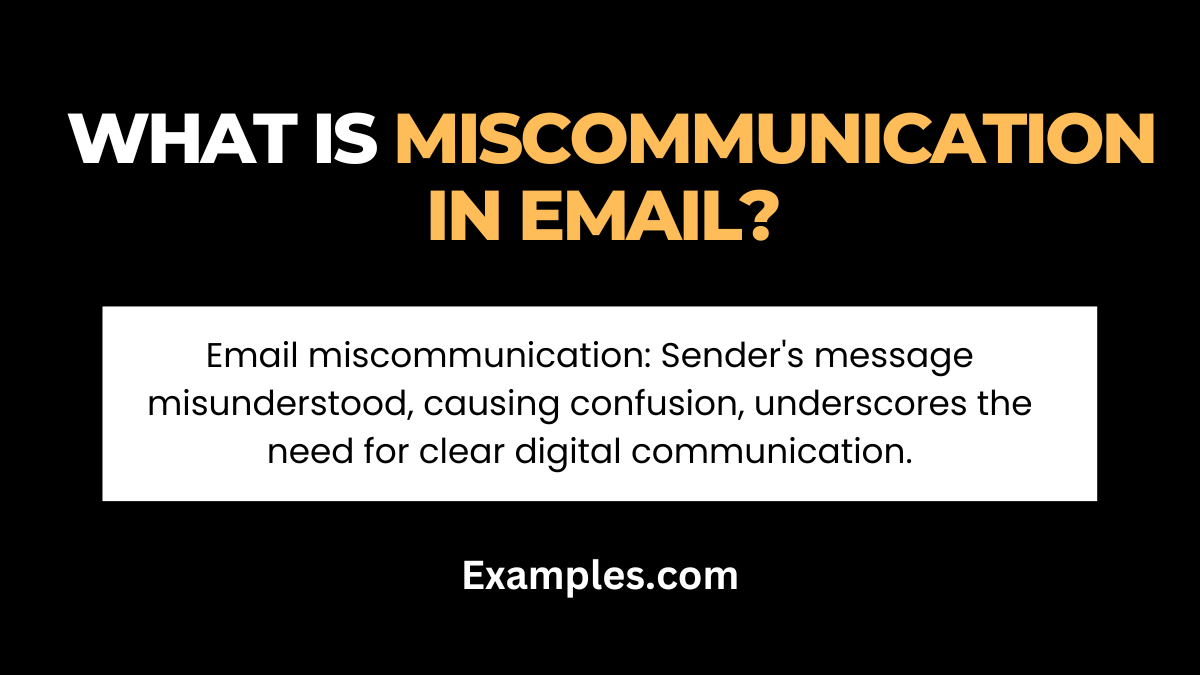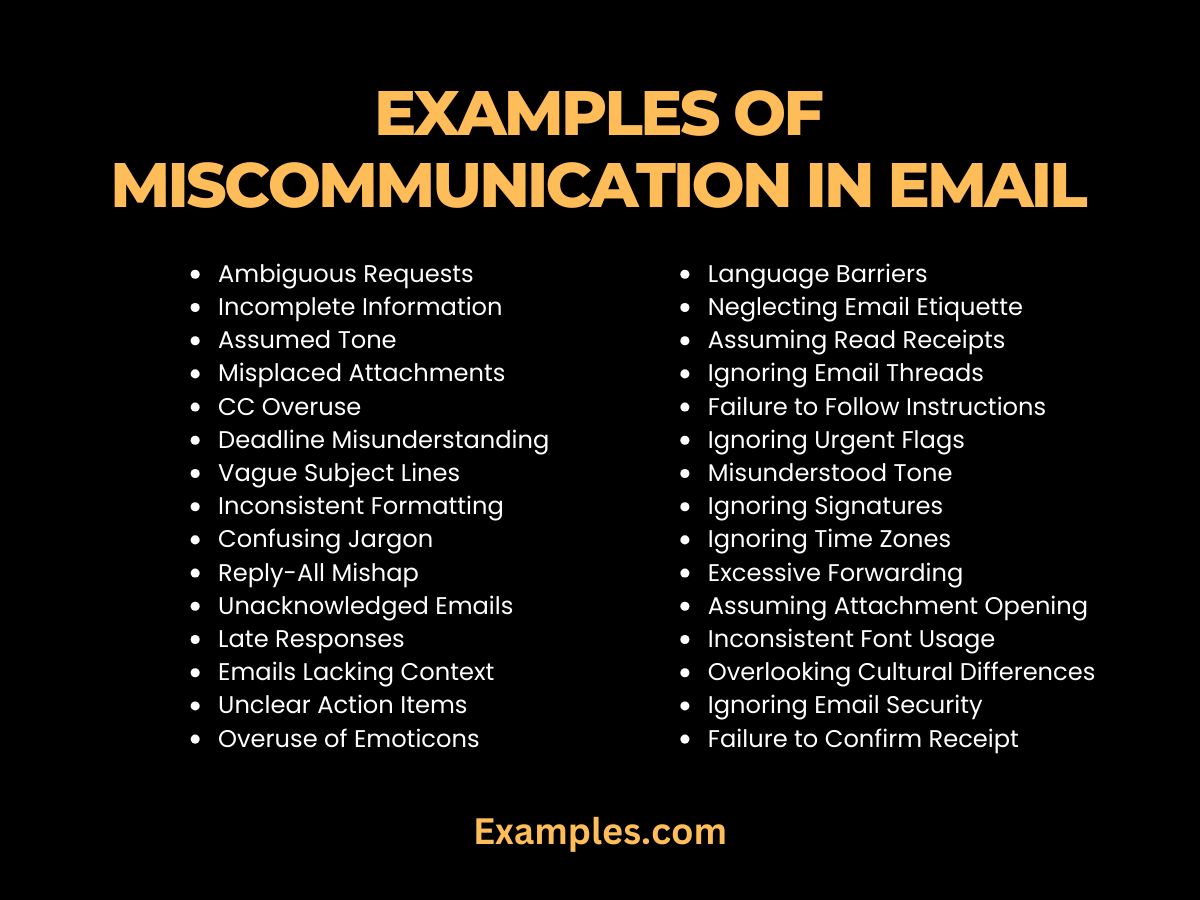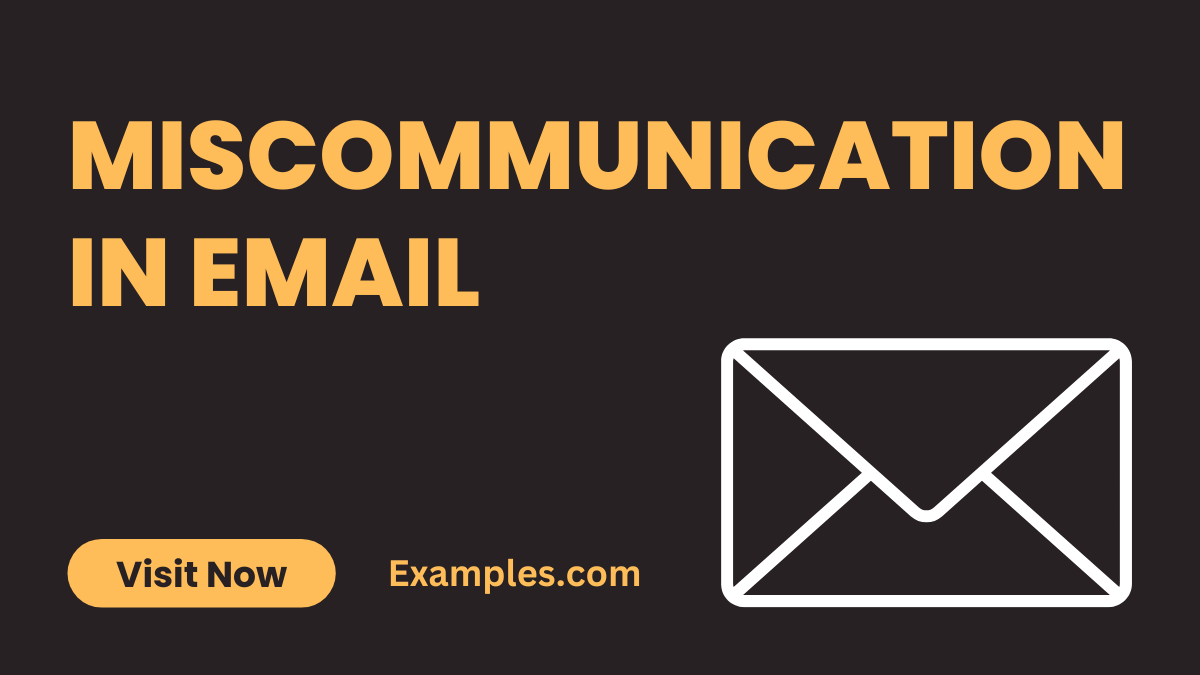29+ Miscommunication in Email Examples
Embark on a comprehensive journey through the intricacies of miscommunication in email. This guide offers insights into common pitfalls, providing real-world Communication Examples to enhance your understanding. Learn to navigate the nuances of digital dialogue, decode subtle cues, and transform your email communication for greater clarity and effectiveness. Elevate your email etiquette and master the art of expressing ideas seamlessly in the virtual realm.
What is Miscommunication in Email? Definition

Miscommunication in email refers to situations where the intended message is not clearly conveyed or is misunderstood. It occurs when the sender’s words are misinterpreted, leading to confusion, errors, or unintended consequences. In simpler terms, it’s when the message sent is not received and understood as intended, creating potential challenges in effective digital communication. Understanding miscommunication in email is crucial for fostering clearer and more impactful online interactions.
What is the most common Example of Miscommunication in Email?

The Reply-All Dilemma stands out as a prevalent example of miscommunication in email. This occurs when an email, intended for a specific recipient or a smaller group, is replied to using the “Reply-All” function. The unintended consequence is that the response is sent to the entire email thread, often including individuals who weren’t meant to receive the reply. This misstep can lead to confusion, irrelevant messages cluttering inboxes, and potential embarrassment for the sender. Awareness and caution are crucial to avoid this common email miscommunication pitfall.
30 Examples of Miscommunication in Email

Dive into our comprehensive guide on 30 instances of miscommunication in email, unraveling the complexities that often accompany digital communication. Explore real-world examples and gain insights into the nuances of virtual dialogues. This resource not only highlights common pitfalls but also offers strategies on how to navigate and overcome these challenges. Elevate your email communication skills, avoid missteps, and foster clearer and more effective digital conversations.
- Ambiguous Requests:
How to Avoid: Clearly outline expectations.
How to Fix: Request clarification and confirm details promptly. - Incomplete Information:
How to Avoid: Provide comprehensive details.
How to Fix: Seek missing information and provide updates. - Assumed Tone:
How to Avoid: Use clear language.
How to Fix: Clarify intentions and apologize for any misunderstandings. - Misplaced Attachments:
How to Avoid: Verify attachments before sending.
How to Fix: Resend the email with the correct attachments. - CC Overuse: How to Avoid: Only CC relevant parties. How to Fix: Send a follow-up email clarifying recipients.
- Deadline Misunderstanding:
How to Avoid: Clearly state deadlines.
How to Fix: Confirm revised deadlines and adjust schedules. - Vague Subject Lines: How to Avoid: Craft specific subject lines.
How to Fix: Add clarity in follow-up emails. - Inconsistent Formatting:
How to Avoid: Use consistent formatting.
How to Fix: Send a revised, formatted version. - Confusing Jargon:
How to Avoid: Minimize industry-specific terms.
How to Fix: Provide explanations or use simpler language. - Reply-All Mishap:
How to Avoid: Double-check recipients.
How to Fix: Apologize and send a clarification to the intended recipients. - Unacknowledged Emails:
How to Avoid: Confirm receipt of important emails.
How to Fix: Follow up to ensure the message was received. - Late Responses:
How to Avoid: Set response time expectations.
How to Fix: Apologize for the delay and provide the necessary information. - Emails Lacking Context:
How to Avoid: Include context in messages.
How to Fix: Offer a brief explanation in a follow-up email. - Unclear Action Items:
How to Avoid: Specify action steps clearly.
How to Fix: Provide a detailed action plan for clarity. - Overuse of Emoticons:
How to Avoid: Use emoticons judiciously.
How to Fix: Clarify the intended tone in a follow-up message. - Language Barriers:
How to Avoid: Simplify language for international recipients.
How to Fix: Provide translations or clarifications. - Neglecting Email Etiquette:
How to Avoid: Follow professional email etiquette.
How to Fix: Acknowledge the oversight and maintain professionalism. - Assuming Read Receipts:
How to Avoid: Confirm preferences for read receipts.
How to Fix: Apologize if assuming incorrectly and request acknowledgment. - Ignoring Email Threads:
How to Avoid: Review complete email threads.
How to Fix: Apologize for oversight and address missed points. - Failure to Follow Instructions:
How to Avoid: Repeat crucial instructions.
How to Fix: Clarify and emphasize the necessary steps. - Ignoring Urgent Flags:
How to Avoid: Respond promptly to flagged emails.
How to Fix: Acknowledge the urgency and respond accordingly. - Misunderstood Tone:
How to Avoid: Use clear language and consider tone.
How to Fix: Clarify intentions and apologize if misinterpreted. - Ignoring Signatures:
How to Avoid: Read email signatures for important details.
How to Fix: Apologize for oversight and address the signature information. - Ignoring Time Zones:
How to Avoid: Consider time zone differences.
How to Fix: Apologize for any inconvenience and adjust future communications. - Excessive Forwarding:
How to Avoid: Limit forwarding to essential information.
How to Fix: Clarify the relevant information and minimize future forwards. - Assuming Attachment Opening:
How to Avoid: Confirm attachment receipt.
How to Fix: Resend the email with necessary attachments and seek confirmation. - Inconsistent Font Usage:
How to Avoid: Use a standard font.
How to Fix: Send a follow-up email with consistent formatting. - Overlooking Cultural Differences:
How to Avoid: Consider cultural nuances.
How to Fix: Acknowledge misunderstandings and clarify cultural context. - Ignoring Email Security:
How to Avoid: Use secure channels for sensitive information.
How to Fix: Apologize and reinforce secure communication protocols. - Failure to Confirm Receipt:
How to Avoid: Request confirmation of receipt.
How to Fix: Follow up to ensure the message was received and understood.
By learning from these examples and implementing proactive communication strategies, individuals can enhance their email skills, minimizing miscommunication pitfalls in the digital realm.
How do you say there has been a miscommunication in email?
Addressing miscommunication in email requires finesse and strategic language. Learn effective ways to convey that a misunderstanding has occurred without assigning blame. This guide provides unique phrases, courteous language, and actionable steps to rectify the miscommunication, fostering a collaborative atmosphere in your digital interactions.
Key Tips:
- Choose Neutral Language: Select words that convey the message without assigning fault.
- Offer Clarification: Provide additional context or details to rectify the misunderstanding.
- Express Willingness to Resolve: Demonstrate a proactive approach to finding a resolution.
- Avoid Accusatory Tone: Frame the message to promote understanding rather than laying blame.
Example Phrases:
- “It appears there might be a misunderstanding regarding…”
- “To clarify, let me revisit the key points…”
- “I believe there might be a miscommunication; let’s work together to ensure clarity…”
- “Could we revisit our recent conversation? It seems there might be some confusion…”
Master the art of diplomatic communication to address miscommunication gracefully in your email exchanges.
How do you avoid miscommunication in an email?
Email miscommunication can lead to various challenges, but with strategic approaches, you can significantly minimize the risk of misunderstandings. This comprehensive guide explores actionable strategies to enhance clarity in your email communication, ensuring your messages are received as intended and reducing the likelihood of confusion.
Key Strategies:
- Precise Language Usage: Craft messages with clear and unambiguous language.
- Clarify Expectations: Clearly outline expectations and deliverables in your emails.
- Use Bullet Points and Formatting: Enhance readability and structure in your emails.
- Avoid Ambiguous Phrases: Steer clear of vague or open-to-interpretation language.
- Request Feedback: Encourage recipients to seek clarification and provide feedback.
Best Practices:
- Proofread Carefully: Review your emails for potential areas of confusion.
- Use Descriptive Subject Lines: Clearly convey the purpose or topic of the email.
- Summarize Key Points: Provide a concise summary of crucial information.
- Consider Your Audience: Tailor your communication style to your audience.
- Encourage Two-Way Communication: Foster an environment where questions are welcomed.
By implementing these strategies and best practices, you can proactively reduce the chances of miscommunication in your email exchanges, fostering a more effective and harmonious digital communication environment.
How to Avoid Tone Issues in Email
Mastering tone in email communication is essential for effective and positive interactions. Explore actionable strategies to sidestep tone-related pitfalls, ensuring that your messages convey the intended sentiment. From careful language selection to considering cultural nuances, this guide equips you with the tools to maintain clarity and foster a constructive digital communication environment.
Key Strategies:
- Choose Words Thoughtfully: Select language that accurately reflects your intended tone.
- Consider the Reader’s Perspective: Anticipate how your words may be interpreted by the recipient.
- Use Emoticons Judiciously: Emoticons can add nuance, but use them sparingly and appropriately.
- Read Aloud Before Sending: Ensure your message reads as intended by vocalizing it before sending.
- Be Mindful of Cultural Differences: Recognize that tone can be perceived differently across cultures.
Best Practices:
- Start with a Greeting: Establish a friendly tone from the beginning.
- Avoid Using All Caps: Writing in all capital letters can be interpreted as shouting.
- Refrain from Sarcasm: Sarcasm can easily be misconstrued in written form.
- Use Positive Language: Frame your message in a positive and constructive manner.
- Provide Context: Clarify intentions and provide context when necessary.
How should one respond to miscommunication in an email?
Miscommunication in email is inevitable, but how you respond can make a significant difference. This guide offers a step-by-step approach to effectively address and resolve misunderstandings. From acknowledging the issue to providing clarity and suggesting solutions, learn how to navigate miscommunication in email and maintain a positive and productive digital communication atmosphere.
Key Steps:
- Acknowledge the Miscommunication: Clearly express awareness of the misunderstanding.
- Seek Clarification: Encourage the recipient to ask questions or seek clarification.
- Provide Additional Context: Offer supplementary information to enhance understanding.
- Propose Solutions: Collaboratively work towards resolving the issue.
- Ensure Clarity Moving Forward: Establish a plan to prevent similar miscommunications in the future.
Best Practices:
- Remain Calm and Professional: Keep your response composed and professional.
- Use Clear and Concise Language: Avoid ambiguity and express yourself clearly.
- Apologize If Necessary: If the miscommunication was due to an error on your part, offer a sincere apology.
- Encourage Open Dialogue: Foster an environment where communication is open and questions are welcomed.
- Follow Up: Confirm that the recipient understands the resolution and is satisfied with the outcome.
By adopting these strategies and best practices, you can navigate tone challenges and respond effectively to miscommunication in email, promoting positive and constructive digital interactions.
How do you apologize for a miscommunication in an email?
Apologizing for miscommunication is crucial to maintaining positive relationships. Follow this guide to craft a thoughtful and effective apology in your email:
Key Components:
- Express Regret: Begin by expressing genuine regret for any confusion caused.
- Take Responsibility: Acknowledge if the miscommunication was a result of your actions or unclear communication.
- Offer a Sincere Apology: Apologize sincerely, demonstrating your commitment to resolving the issue.
- Provide Clarification: Offer additional context or information to clarify the intended message.
- Propose Solutions: If applicable, suggest practical solutions to rectify any misunderstandings.
- Commit to Improvement: Convey your dedication to improving communication to prevent similar issues in the future.
Best Practices:
- Timely Apology: Respond promptly to address the issue before it escalates.
- Use Polite and Professional Language: Maintain a courteous and professional tone throughout your apology.
- Avoid Blame-Shifting: Refrain from blaming others and focus on finding constructive solutions.
- Encourage Feedback: Invite the recipient to provide feedback on how communication can be improved.
- Follow Up: Ensure that the recipient acknowledges the apology and is satisfied with the resolution.
By adhering to these practices, you can respond effectively to miscommunication in email, fostering understanding and maintaining positive communication channels.
Email miscommunication, evident in the Reply-All Dilemma and various examples, highlights the importance of clarity in digital communication. This guide emphasizes proactive measures—clearly outlining expectations, providing comprehensive details, and avoiding pitfalls like ambiguous requests. Awareness and caution are key to fostering effective email communication, minimizing errors, and promoting a more streamlined and impactful digital interaction.



